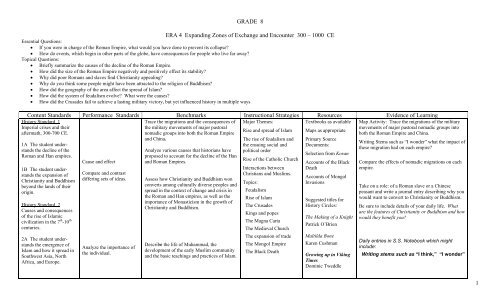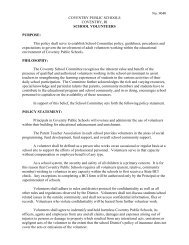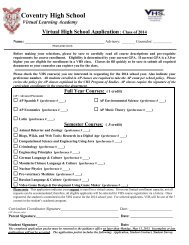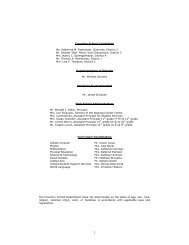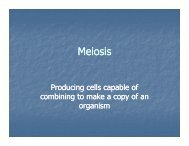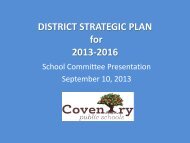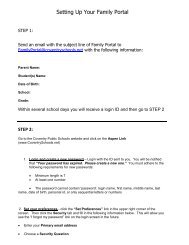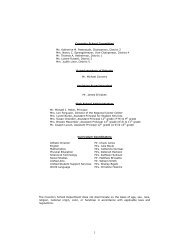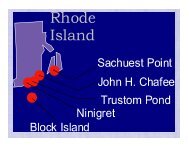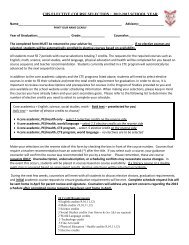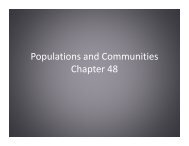Grade08 - Coventry Public Schools
Grade08 - Coventry Public Schools
Grade08 - Coventry Public Schools
- No tags were found...
You also want an ePaper? Increase the reach of your titles
YUMPU automatically turns print PDFs into web optimized ePapers that Google loves.
GRADE 8ERA 4 Expanding Zones of Exchange and Encounter 300 – 1000 CEEssential Questions:• If you were in charge of the Roman Empire, what would you have done to prevent its collapse?• How do events, which begin in other parts of the globe, have consequences for people who live far away?Topical Questions:• Briefly summarize the causes of the decline of the Roman Empire.• How did the size of the Roman Empire negatively and positively effect its stability?• Why did poor Romans and slaves find Christianity appealing?• Why do you think some people might have been attracted to the religion of Buddhism?• How did the geography of the area affect the spread of Islam?• How did the system of feudalism evolve? What were the causes?• How did the Crusades fail to achieve a lasting military victory, but yet influenced history in multiple waysContent Standards Performance Standards Benchmarks Instructional Strategies Resources Evidence of LearningHistory Standard 1Major Themes:Textbooks as available Map Activity: Trace the migrations of the militaryImperial crises and theirmovements of major pastoral nomadic groups intoRise and spread of Islam Maps as appropriateaftermath, 300-700 CE.both the Roman Empire and China.1A The student understandsthe decline of theRoman and Han empires.1B The student understandsthe expansion ofChristianity and Buddhismbeyond the lands of theirorigin.History Standard 2Causes and consequencesof the rise of Islamiccivilization in the 7 th -10 thcenturies.2A The student understandsthe emergence ofIslam and how it spread inSouthwest Asia, NorthAfrica, and Europe.Cause and effectCompare and contrastdiffering sets of ideas.Analyze the importance ofthe individual.Trace the migrations and the consequences ofthe military movements of major pastoralnomadic groups into both the Roman Empireand China.Analyze various causes that historians haveproposed to account for the decline of the Hanand Roman Empires.Assess how Christianity and Buddhism wonconverts among culturally diverse peoples andspread in the context of change and crisis inthe Roman and Han empires, as well as theimportance of Monasticism in the growth ofChristianity and Buddhism.Describe the life of Muhammad, thedevelopment of the early Muslim communityand the basic teachings and practices of Islam.The rise of feudalism andthe ensuing social andpolitical orderRise of the Catholic ChurchInteractions betweenChristians and Muslims.Topics:FeudalismRise of IslamThe CrusadesKings and popesThe Magna CartaThe Medieval ChurchThe expansion of tradeThe Mongol EmpireThe Black DeathPrimary SourceDocuments:Selection from KoranAccounts of the BlackDeathAccounts of MongolInvasionsSuggested titles forHistory Circles:The Making of a KnightPatrick O’BrienMaltilda BoneKaren CushmanGrowing up in VikingTimesDominic TweddleWriting Stems such as “I wonder” what the impact ofthese migration had on each empire?Compare the effects of nomadic migrations on eachempire.Take on a role: of a Roman slave or a Chinesepeasant and write a journal entry describing why youwould want to convert to Christianity or Buddhism.Be sure to include details of your daily life. Whatare the features of Christianity or Buddhism and howwould they benefit you?Daily entries in S.S. Notebook which mightinclude:Writing stems such as “I think,” “I wonder”1
GRADE 8ERA 4 Expanding Zones of Exchange and Encounter 300 – 1000 CEContent Standards Performance Standards Benchmarks Instructional Strategies Resources Evidence of Learning2B The student understandsCause and effectAnalyze the sources and development ofThe White Stag (Attilla Connections to vocabulary, places andthe significance ofIslamic Law and its influence on religiousthe Hun) Kate Seredyevents of todaythe Abbasid Caliphate as apractice, family life, moral behavior,center of culturalmarriage, inheritance, and slavery.Silk Route John Major To what might the Crusades be comparedinnovation and hub ofTodayinterregional trade in theGrowing up in Ancient8 th To what might the Black Death be compared-10 centuries.China Ken Teaguetoday?2C The student understandsthe consolidation ofthe Byzantine state in thecontext of expandingIslamic civilization.History Standard 4The search for political,social, and culturalredefinition in Europe,500-1000 CE.4A The student understandsthe coalescence ofpolitical and social order inEuropeHistory Standard 5The development ofagricultural societies andnew states in tropicalAfrica and Oceania5A The student understandsstate-building inNortheast and West Africaand southward migrationsof Bantu-speaking peoples.Reconstruct patterns ofhistorical succession andduration.Analyze cause and effect.Interrogate historical data.Examine the influence ofideas.Explain how the Byzantine state withstoodArab Muslim attacks between the 7 th and 10 thcenturies.Evaluate the Byzantine role in preserving andtransmitting ancient Greek learning.Assess the impact of Norse (Viking) andMagyar migrations and invasions, as well asinternal conflicts, on the emergence ofindependent lords and the knightly class.Assess changes in the legal, social, andeconomic status of peasants in the 9 th and 10 thcenturies.Analyze the importance of monasteries andconvents as centers of political power,economic productivity, and communal life.Explain how the contrasting naturalenvironments of West Africa definedagricultural production, and analyze theimportance of the Niger River in promotingagriculture, commerce and state building.Catherine Called BirdyKaren CushmanMidwife’s ApprenticeKaren ChusmanAdam of the RoadElizabeth Gray ViningThe Ch’lin PurseLinda FangThe Terra Cotta Armyof Emperor QinCaroline LazoOngoing Timeline entriesGeography Study:What were the geographic barriers theMongol’s faced?What were the geographic barriers theCrusaders faced?Map Study:The routes of the spread of IslamThe routes the Crusaders followed on theirway to JerusalemMarco Polo’s route to China; the silk routesGenghis Khan’s route of Mongolia throughChina and beyondContinents and regions affected by theBlack DeathCulture Study:-The importance of Islam or the Catholic Church inshaping the lives of the people at the time2
GRADE 8ERA 4 Expanding Zones of Exchange and Encounter 300 – 1000 CEContent Standards Performance Standards Benchmarks Instructional Strategies Resources Evidence of LearningHistory Standard 6The rise of centers ofcivilization inMesoamerica and AndeanSouth America in the firstmillennium CE.6A The student understandsthe origins,expansion, andachievements of Mayacivilization.History Standard 7Major global trends from300-1000 CE.Geography Standard 1How the forces ofcooperation and conflictamong people influence thedivision and control ofEarth’s surfaceAnalyze cause and effect.Draw upon visual sourcesEvaluate major debatesamong historians.Standard 7 may be used asan assessment of ERA 4Describe the natural environment of SouthernMesoamerica and its relationship to thedevelopment of Maya urban society.Analyze the Maya system of agriculturalproduction and trade and its relationship to therise of city-states.Analyze how monumental architecture andother evidence portrays the lives of elite menand women.Assess interpretations of how and why Mayacivilization declined.Standard 7 can be used as an assessment for ERA4.See National Standards for History Book: pages 162-163.03
GRADE 8ERA 5 Intensified Hemispheric Interactions, 1000 - 1500 CEContent Standards Performance Standards Benchmarks Instructional Strategies Resources Evidence of LearningHistory Standard 1The maturing of aninterregional system ofcommunication, trade, andcultural exchange in an eraof Chinese economicpower and Islamicexpansion.1A The student understandsChina’s extensiveurbanization andcommercial expansionbetween the 10 th and 13 thcenturies.1B The student understandshow pastoralmigrations and religiousreform movementsbetween the 11 th and 13 thcenturies contributed to therise of new states and theexpansion of Islam.1C The student understandshow interregionalcommunication and tradelet to intensified culturalexchanges among diversepeoples of Eurasia andAfrica.Analyze multiple causation.Examine the influence ofideas.Formulate historicalquestions.Appreciate historicalperspectives.Draw upon data in historicalmaps.Interrogate historical data.Clarify information on thegeographical setting.Analyze how improved agriculturalproduction, population growth, urbanization,and commercialization were interconnected.Identify major technological and scientificinnovations and analyze their effects onChinese life.Analyze the growth of an economicallypowerful merchant class in China.Evaluate scientific, artistic, and literaryachievements of Islamic civilization.Identify the maritime routes extending fromEast Asia to northern Europe and assess theimportance of trade across the Indian Oceanfor societies of Asia, East Africa, and Europe.Explain how camel caravan transportfacilitated long-distance trade across CentralAsia and the Sahara Desert.Jigsaw Activity: Divide into small groups and read aselection from A Thousand and One Nights. Eachgroup will report on their story and then the classwill reflect on what the stories reveal about themultiethnic character of the Islamic state? What dothe tales tell about life in the 11 th to 13 th centuries inthe Arabian peninsula?Graphic Organizer to chart information: Scientificachievements of the Islamic civilizations. Whatwere their innovations?Adopting a persona: (seeing another point of view)You are a Bedouin herder at the time Muhammadwas beginning to preach. Write a speech to deliverto fellow Bedouins. In the speech tell why you thinkMuhammad’s teachings will improve your life.What did he teach about family life, moral behavior,slavery, etc.?History CirclesConstruct a drawing of a medieval manor showingall the major structures and identifying where thepeople of different social classes lived.Costs and Benefits Chart:Chart out the benefits that the manorial systemprovided for each group of people who lived on amanor. What did it “cost” them or what did theyhave to give up?Adopting a persona: (to understand/recreate life atthe time). Pretend you are a serf, a page, a prince orprincess, or a kitchen helper in the castle. Describewhat your average day is like.4
2A The student understandsfeudalism and thegrowth of centralizedmonarchies and city-statesin Europe.GRADE 8ERA 5 Intensified Hemispheric Interactions, 1000 - 1500 CEContent Standards Performance Standards Benchmarks Instructional Strategies Resources Evidence of LearningCompare the importance of such cities asHistory Standard 2Canton, Melaka, Calicut, Samarkand, Kilwa,The redefining of EuropeanCairo, Constantinople, and Venice as centerssociety and culture, 1000-of international trade and cosmopolitan1300 CE.Interrogate historical data. culture.Appreciate historicalperspectives.Analyze cause and effectrelationships.Identify relevant historicalantecedents.Describe feudal lordship and explain howfeudal relationships provided a foundation ofpolitical order.Describe manorialism and serfdom asinstitutions of medieval Europe and analyzehow population growth and agriculturalexpansion effected the legal position andworking lives of peasant men and women.Analyze how European monarchies expandedtheir power at the expense of feudal lords.Analyze the significance of developments inmedieval English legal and constitutionalpractice in their importance for moderndemocratic thought and institutions.Researching a significant historical occurrence:Gather information about the Black Death throughresearch and primary source documents. Think aboutthe following questions:Who were most likely to get the plague?How did it spread?What would/could you have done if you were in avillage and found out that a deadly mysteriousdisease was threatening your village?What were things others did at the time?How serious was the plague?Create a book about or construct a model of aEuropean castle of the 12 th or 13 th century. Whatwere the purposes of the various parts of the castleboth inside and out? In what ways did the life of thecastle depend on the work of serfs? In what ways didserfs depend on the castle and its inhabitants?2B The student understandsthe expansion ofChristian Europe after 1000Analyze cause and effectsrelationships.Analyze connections between populationgrowth and increased agricultural productionand technological innovation.Interrogate historical data.Analyze cause and effectrelationship.Analyze the success of Christian states inoverthrowing Muslim powers in central andsouthern Iberia.Analyze the causes and consequences of theEuropean Crusades against Syria andPalestine.2C The student understandsthe patterns of socialchange and culturalachievement in Europe’semerging civilizations.Analyze cause and effectrelationship.Examine the influence ofideas.Analyze ways in which ideals of chivalry andcourtly love affected feudal society.Describe the life of Jewish communities andtheir contributions to Europe’s cultural and5
GRADE 8ERA 5 Intensified Hemispheric Interactions, 1000 - 1500 CEContent Standards Performance Standards Benchmarks Instructional Strategies Resources Evidence of LearningDraw upon visual sources. economic development.History Standard 3The rise of the Mongolempire and itsconsequences for Eurasianpeoples, 1200-1350.Analyze how the rise of schools anduniversities in Italy, France, and Englandcontributed to literacy, learning, and scientificadvancement.Evaluate major works of art, architecture, andliterature and analyze how they shed light onvalues and attitudes in Christian society.3A The student understandsthe world-historicalsignificance of the Mongolempire.3B The student understandsthe significance ofMongol rule in China,Korea, Russia, andSouthwest Asia.Access the importance ofthe individual.Analyze cause and effectrelationships.Draw upon data andhistorical maps.Assess the career of Genghis Khan as aconqueror and military motivator in thecontext of Mongol society.Describe the Mongol conquests of 1206-1279and assess their effects onPeoples of China, Southeast Asia, Russia, andSouthwest Asia.6
GRADE 8ERA 5 Intensified Hemispheric Interactions, 1000 - 1500 CEContent Standards Performance Standards Benchmarks Instructional Strategies Resources Evidence of LearningHistory Standard 4The growth of states,towns, and trade in Sub-Saharan Africa between the11 th and 15 th centuriesAnalyze cause and effectrelationships.Draw upon data andhistorical maps.Analyze the importance of agriculture, goldproduction, and the trans-Saharan caravantrade in the growth of the Mali and Songhayempires.4A The student understandsthe growth ofimperial states in WestAfrica and Ethiopia.Examine the influence ofideas.Analyze cause and effectrelationships.Explain how Islam expanded in West Africaand assess its importance in the political andcultural life of 1. W. Africa -Mali andSonghay, and 2. E. African coast.History Standard 5Patterns of crisis andrecovery in Afro-Eurasia,1300-1450.5A The student understandsthe consequences ofBlack Death and recurringplague pandemic in the 14 thcentury.5B The student understandstransformations inEurope following theeconomic anddemographic crises of the14 th century.5C The student understandsmajor politicaldevelopments in Asia inthe aftermath of theReconstruct patterns ofhistorical succession andduration.Evidence historicalperspectives.Analyze cause and effectrelationships.Appreciate historicalperspective.Analyze cause and effectrelationships.Evaluate the implementationof a decision.Explain the origins and characteristics of theplague pandemic of the mid 14 th century, anddescribe its spread across Eurasia and NorthAfrica.Analyze the demographic, economic, socialand political effects of the plague pandemic inEurasia and North Africa in the second half ofthe 14 th century.Analyze major changes in the agrarian andcommercial economies of Europe in thecontext of drastic population decline.Assess the effects of crises in the CatholicChurch on its organization and prestigeAnalyze causes and consequences of theHundred Years War and repeated popularuprisings in Europe in the 14 th century.7
GRADE 8ERA 5 Intensified Hemispheric Interactions, 1000 - 1500 CEContent Standards Performance Standards Benchmarks Instructional Strategies Resources Evidence of Learningcollapse of Mongol ruleand the plague pandemic.Analyze cause and effectrelationships (importance ofindividual).Reconstruct patterns ofsuccession and duration.Describe the Zheng He maritime expeditionsof the early 15 th century and analyze why theMing state initiated, then terminated, thesevoyages.Assess the impact of the conquests of Timur(Tamerlane) on Central Asia, Southwest Asia,and India and evaluate Timurid contributionsto arts and sciences.Analyze the origins and early expansion of theOttoman state up to the capture ofConstantinople.History Standard 6The student understandsthe development ofcomplex societies andstates in North Americaand Mesoamerica.Compare and contrastdiffering values andinstitutions.Interrogate historical data.Formulate historicalquestions.Explain major characteristics of Toltecs,Anasazi, Pueblo, and North American moundbuildingpeoples.Analyze how the Aztec empire arose in the14 th and 15 th centuries and explain majoraspects of Aztec government, society,religion, and culture.Analyze patterns of long-distance tradecentered in Mesoamerica.8


